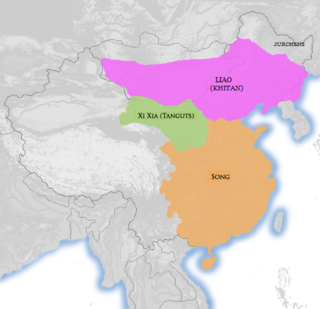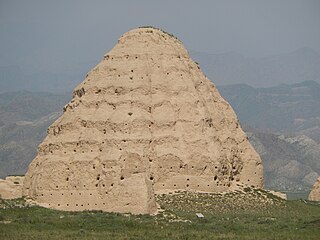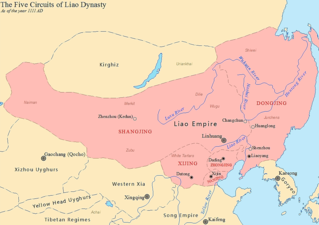
The Jin dynasty, officially known as the Great Jin, was an imperial dynasty of China that existed between 1115 and 1234. Because the Wanyan clan that founded the dynasty were of Jurchen descent, it is also sometimes called the Jurchen dynasty or the Jurchen Jin.

The Five Dynasties and Ten Kingdoms period was an era of political upheaval and division in Imperial China from 907 to 979. Five dynastic states quickly succeeded one another in the Central Plain, and more than a dozen concurrent dynastic states, collectively known as the Ten Kingdoms, were established elsewhere, mainly in South China. It was a prolonged period of multiple political divisions in Chinese imperial history.

The Western Xia or the Xi Xia (Chinese: 西夏; pinyin: Xī Xià; Wade–Giles: Hsi1 Hsia4), officially the Great Xia (大夏; Dà Xià; Ta4 Hsia4), also known as the Tangut Empire, and known as Mi-nyak to the Tanguts and Tibetans, was a Tangut-led Buddhist imperial dynasty of China that existed from 1038 to 1227. At its peak, the dynasty ruled over modern-day northwestern China, including parts of Ningxia, Gansu, eastern Qinghai, northern Shaanxi, northeastern Xinjiang, and southwest Inner Mongolia, and southernmost Outer Mongolia, measuring about 800,000 square kilometres (310,000 square miles).
This is a list of historical capitals of China.
For most of its history, China was organized into various dynastic states under the rule of hereditary monarchs. Beginning with the establishment of dynastic rule by Yu the Great c. 2070 BC, and ending with the abdication of the Xuantong Emperor in AD 1912, Chinese historiography came to organize itself around the succession of monarchical dynasties. Besides those established by the dominant Han ethnic group or its spiritual Huaxia predecessors, dynasties throughout Chinese history were also founded by non-Han peoples.
Taizong is the temple name used for several monarchs of China. It may refer to:
Taizu is a temple name typically, but not always, used for Chinese monarchs who founded a particular dynasty, may refer to:

Dingnan Jiedushi (simplified Chinese: 定难节度使; traditional Chinese: 定難節度使), also known as Xiasui Jiedushi, was a jiedushi created in 787 by the Tang dynasty that lasted until the early Northern Song dynasty, when its ruler Li Yuanhao proclaimed himself emperor and established the Western Xia dynasty. Its seat was in modern Yulin, Shaanxi. Its rulers were of Tangut ethnicity starting from Li Sigong, and they effectively ruled the circuit in de facto independence despite its nominal submission to the central Chinese dynasties. Attempts by the Later Tang and Song dynasty to dislodge the family from its rule of Dingnan Jiedushi were unsuccessful, and the region eventually became the independent dynasty of Western Xia.
Emperor Chongzong of Western Xia (1084–1139), born Li Qianshun, was the fourth emperor of the Western Xia dynasty of China, ruling from 1086 to 1139. His reign began at the age of three, when his father Li Bingchang died. He remained under the regency of the Empress Dowager Zhaojian until she was poisoned in 1099 by a Liao envoy.

Li Jiqian (963–1004), occasionally also known by his Song-bestowed name of Zhao Baoji (趙保吉), was a Tangut leader and progenitor of China's Western Xia dynasty. He resisted the Song dynasty and organized a rebellion in 984. He also created a successful alliance with the Liao dynasty for military support. Li Jiqian arranged a peace agreement with the Song emperor, but violated the treaty himself. To avoid costly military campaigns, Emperor Zhenzong of Song made Li Jiqian the jiedushi of Dingnan (定難節度使), and recognized Li Jiqian's new autonomous rule. He supported the construction of irrigation canals that were crucial for the development of agriculture in the arid areas of northwestern China, especially around the capital Xingqing.
Li Renfu (李仁福), possibly né Tuoba Renfu (拓拔仁福), formally the Prince of Guo (虢王), was an ethnic Dangxiang (Tangut) warlord during the Five Dynasties and Ten Kingdoms period, ruling Dingnan Circuit from 909 or 910 to his death in 933, as its military governor (jiedushi) in de facto independence.
Emperor Jingzong of Western Xia (1003–1048), born Li Yuanhao or Tuoba Yuanhao, also known as Zhao Yuanhao (趙元昊), Weiming Yuanhao (嵬名元昊) and Weiming Nangxiao (嵬名曩霄), was the founding emperor of the Western Xia dynasty of China, reigning from 1038 to 1048. He was the eldest son of the Tangut ruler Li Deming.

The Sixteen Prefectures of Yanyun comprise a historical region in northern China along the Great Wall in present-day Beijing, Tianjin, and part of northern Hebei and Shanxi. It was a site of constant military and political conflict between various dynasties from the end of the Tang dynasty until the establishment of the Yuan dynasty.
The Song dynasty of China was an imperial dynasty that ruled most of China proper and southern China from the middle of the 10th century into the last quarter of the 13th century. The dynasty was established by Emperor Taizu of Song with his usurpation of the throne of Later Zhou, ending the Five Dynasties and Ten Kingdoms period.

The Liao dynasty, also known as the Khitan Empire, officially the Great Liao, was an imperial dynasty of China that existed between 916 and 1125, ruled by the Yelü clan of the Khitan people. Founded around the time of the collapse of the Tang dynasty, at its greatest extent it ruled over Northeast China, the Mongolian Plateau, the northern part of the Korean Peninsula, southern portions of the Russian Far East, and the northern tip of the North China Plain.
The Sixteen Kingdoms, less commonly the Sixteen States, was a chaotic period in Chinese history from AD 304 to 439 when northern China fragmented into a series of short-lived dynastic states. The majority of these states were founded by the "Five Barbarians", non-Han peoples who had settled in northern and western China during the preceding centuries, and had launched a series of rebellions against the Western Jin dynasty in the early 4th century. However, several of the states were founded by the Han people, and all of the states—whether ruled by Xiongnu, Xianbei, Di, Jie, Qiang, Han, or others—took on Han-style dynastic names. The states frequently fought against both one another and the Eastern Jin dynasty, which succeeded the Western Jin in 317 and ruled southern China. The period ended with the unification of northern China in 439 by the Northern Wei, a dynasty established by the Xianbei Tuoba clan. This occurred 19 years after the Eastern Jin collapsed in 420, and was replaced by the Liu Song dynasty. Following the unification of the north by Northern Wei, the Northern and Southern dynasties era of Chinese history began.

The Ganzhou Uyghur Kingdom, also referred to as the Hexi Uyghurs, was established in 894 around Ganzhou in modern Zhangye. The kingdom lasted from 894 to 1036; during that time, many of Ganzhou's residents converted to Buddhism.

The Western Xia was a Tangut-led Chinese dynasty which ruled over what are now the northwestern Chinese subdivisions of Ningxia, Gansu, eastern Qinghai, northern Shaanxi, northeastern Xinjiang, southwest Inner Mongolia, and southernmost Outer Mongolia from 1032 until 1227 when they were destroyed by the Mongols. The country was established by the Tangut people; likewise its earliest coins were escribed with Tangut characters, while later they would be written in Chinese. Opposed to Song dynasty coins that often read top-bottom-right-left, Western Xia coins exclusively read clockwise. Despite the fact that coins had been cast for over a century and a half, very little were actually produced and coins from Western Xia are a rarity today. Although the Western Xia cast their own coins barter remained widely used.
The Song–Xia wars were a series of military conflicts fought by the Northern Song dynasty, Western Xia dynasty, and Liao dynasty from the late 10th century to early 12th century. Although sporadic conflicts would continue, the Northern Song lost their land border with the Western Xia after the Jin–Song Wars and the Jingkang Incident of 1127 which saw the fall of their capital, Kaifeng, to the Jurchen-led Jin dynasty.
Ningling Ge was a crown prince of the Western Xia dynasty and the fourth son of the Emperor Jingzong, the founding monarch. Ningling Ge was a member of Tangut Weiming (嵬名) clan.
















































